最近学习Spring对mdb(消息驱动Bean)的支持,折腾了两个星期,总算搞定了。现将配置总结如下:
一.ejb部分。
mdb类:
 package
com.mdb.ejb;
package
com.mdb.ejb;
 import
javax.ejb.EJBException;
import
javax.ejb.EJBException; import
javax.ejb.MessageDrivenBean;
import
javax.ejb.MessageDrivenBean; import
javax.ejb.MessageDrivenContext;
import
javax.ejb.MessageDrivenContext; import
javax.jms.JMSException;
import
javax.jms.JMSException; import
javax.jms.Message;
import
javax.jms.Message; import
javax.jms.MessageListener;
import
javax.jms.MessageListener; import
javax.jms.TextMessage;
import
javax.jms.TextMessage;

 /** */
/**
/** */
/** * XDoclet-based Message Driven entity bean.
* XDoclet-based Message Driven entity bean. *
*  * To generate EJB related classes using XDoclet: - Add Standard EJB module to
* To generate EJB related classes using XDoclet: - Add Standard EJB module to * XDoclet project properties - Customize XDoclet configuration - Run XDoclet
* XDoclet project properties - Customize XDoclet configuration - Run XDoclet *
*  * Below are the xdoclet-related tags needed for this EJB.
* Below are the xdoclet-related tags needed for this EJB. *
*  * @ejb.bean name="Hello" display-name="Name for Hello" description="Description
* @ejb.bean name="Hello" display-name="Name for Hello" description="Description * for Hello" destination-type="javax.jms.Queue"
* for Hello" destination-type="javax.jms.Queue" * acknowledge-mode="Auto-acknowledge"
* acknowledge-mode="Auto-acknowledge" * @weblogic.pool max-beans-in-free-pool="10" initial-beans-in-free-pool="2"
* @weblogic.pool max-beans-in-free-pool="10" initial-beans-in-free-pool="2" * @weblogic.message-driven destination-jndi-name="ejb/Hello"
* @weblogic.message-driven destination-jndi-name="ejb/Hello" * initial-context-factory="weblogic.jndi.WLInitialContextFactory"
* initial-context-factory="weblogic.jndi.WLInitialContextFactory" * connection-factory-jndi-name="helloConnectionFactory"
* connection-factory-jndi-name="helloConnectionFactory" */
*/

 public
class
HelloBean
implements
MessageDrivenBean, MessageListener
...
{
public
class
HelloBean
implements
MessageDrivenBean, MessageListener
...
{ private static final long serialVersionUID = 1L;
private static final long serialVersionUID = 1L;

 /** *//** The MessageDrivenContext */
/** *//** The MessageDrivenContext */ MessageDrivenContext context;
MessageDrivenContext context;

 public HelloBean() ...{
public HelloBean() ...{ super();
super(); // TODO Auto-generated constructor stub
// TODO Auto-generated constructor stub }
}

 /** *//**
/** *//** * Set the associated context. The container calls this method after the
* Set the associated context. The container calls this method after the * instance creation. <br>
* instance creation. <br> *
*  * The enterprise bean instance should store the reference to the context
* The enterprise bean instance should store the reference to the context * object in an instance variable. <br>
* object in an instance variable. <br> *
*  * This method is called with no transaction context.
* This method is called with no transaction context. *
*  * @param newContext
* @param newContext * A MessageDrivenContext interface for the instance.
* A MessageDrivenContext interface for the instance. *
*  * @throws EJBException
* @throws EJBException * Thrown by the method to indicate a failure caused by a
* Thrown by the method to indicate a failure caused by a * system-level error.
* system-level error. */
*/ public void setMessageDrivenContext(MessageDrivenContext newContext)
public void setMessageDrivenContext(MessageDrivenContext newContext)
 throws EJBException ...{
throws EJBException ...{ context = newContext;
context = newContext; }
}

 public void ejbRemove() throws EJBException ...{
public void ejbRemove() throws EJBException ...{ // TODO Auto-generated method stub
// TODO Auto-generated method stub
 }
}

 public void onMessage(Message recvMsg) ...{
public void onMessage(Message recvMsg) ...{ System.out.println("HelloBean接收到的消息:");
System.out.println("HelloBean接收到的消息:");
 try ...{
try ...{ TextMessage message = (TextMessage) recvMsg;
TextMessage message = (TextMessage) recvMsg; System.out.println(message.getText());
System.out.println(message.getText());
 } catch (JMSException e) ...{
} catch (JMSException e) ...{ e.printStackTrace();
e.printStackTrace(); }
} }
}

 /** *//**
/** *//** * An ejbCreate method as required by the EJB specification.
* An ejbCreate method as required by the EJB specification. *
*  * The container calls the instance?s <code>ejbCreate</code> method
* The container calls the instance?s <code>ejbCreate</code> method * immediately after instantiation.
* immediately after instantiation. *
*  * @ejb.create-method
* @ejb.create-method */
*/
 public void ejbCreate() ...{
public void ejbCreate() ...{ }
}
 }
}

ejb-jar.xml:
 <?
xml version="1.0" encoding="UTF-8"
?>
<?
xml version="1.0" encoding="UTF-8"
?>

 <!
DOCTYPE ejb-jar PUBLIC "-//Sun Microsystems, Inc.//DTD Enterprise JavaBeans 2.0//EN" "http://java.sun.com/dtd/ejb-jar_2_0.dtd"
>
<!
DOCTYPE ejb-jar PUBLIC "-//Sun Microsystems, Inc.//DTD Enterprise JavaBeans 2.0//EN" "http://java.sun.com/dtd/ejb-jar_2_0.dtd"
>

 <
ejb-jar
>
<
ejb-jar
>

 <
description
>
<![CDATA[
No Description.
]]>
</
description
>
<
description
>
<![CDATA[
No Description.
]]>
</
description
>
 <
display-name
>
Generated by XDoclet
</
display-name
>
<
display-name
>
Generated by XDoclet
</
display-name
>

 <
enterprise-beans
>
<
enterprise-beans
>
 <!--
<!--
 To add session beans that you have deployment descriptor info for, add
To add session beans that you have deployment descriptor info for, add a file to your XDoclet merge directory called session-beans.xml that contains
a file to your XDoclet merge directory called session-beans.xml that contains the <session></session> markup for those beans.
the <session></session> markup for those beans. -->
-->

 <!--
Entity Beans
-->
<!--
Entity Beans
-->
 <!--
<!--
 To add entity beans that you have deployment descriptor info for, add
To add entity beans that you have deployment descriptor info for, add a file to your XDoclet merge directory called entity-beans.xml that contains
a file to your XDoclet merge directory called entity-beans.xml that contains the <entity></entity> markup for those beans.
the <entity></entity> markup for those beans. -->
-->

 <!--
Message Driven Beans
-->
<!--
Message Driven Beans
-->
 <
message-driven
>
<
message-driven
>
 <
description
>
<![CDATA[
Description for Hello
]]>
</
description
>
<
description
>
<![CDATA[
Description for Hello
]]>
</
description
>
 <
display-name
>
Name for Hello
</
display-name
>
<
display-name
>
Name for Hello
</
display-name
>

 <
ejb-name
>
Hello
</
ejb-name
>
<
ejb-name
>
Hello
</
ejb-name
>

 <
ejb-class
>
com.mdb.ejb.HelloBean
</
ejb-class
>
<
ejb-class
>
com.mdb.ejb.HelloBean
</
ejb-class
>

 <
transaction-type
>
Container
</
transaction-type
>
<
transaction-type
>
Container
</
transaction-type
>
 <
acknowledge-mode
>
Auto-acknowledge
</
acknowledge-mode
>
<
acknowledge-mode
>
Auto-acknowledge
</
acknowledge-mode
>
 <
message-driven-destination
>
<
message-driven-destination
>
 <
destination-type
>
javax.jms.Queue
</
destination-type
>
<
destination-type
>
javax.jms.Queue
</
destination-type
>
 </
message-driven-destination
>
</
message-driven-destination
>

 </
message-driven
>
</
message-driven
>

 <!--
<!--
 To add message driven beans that you have deployment descriptor info for, add
To add message driven beans that you have deployment descriptor info for, add a file to your XDoclet merge directory called message-driven-beans.xml that contains
a file to your XDoclet merge directory called message-driven-beans.xml that contains the <message-driven></message-driven> markup for those beans.
the <message-driven></message-driven> markup for those beans. -->
-->

 </
enterprise-beans
>
</
enterprise-beans
>

 <!--
Relationships
-->
<!--
Relationships
-->

 <!--
Assembly Descriptor
-->
<!--
Assembly Descriptor
-->
 <!--
<!--
 To specify your own assembly descriptor info here, add a file to your
To specify your own assembly descriptor info here, add a file to your XDoclet merge directory called assembly-descriptor.xml that contains
XDoclet merge directory called assembly-descriptor.xml that contains the <assembly-descriptor></assembly-descriptor> markup.
the <assembly-descriptor></assembly-descriptor> markup. -->
-->

 <
assembly-descriptor
>
<
assembly-descriptor
>
 <!--
<!--
 To specify additional security-role elements, add a file in the merge
To specify additional security-role elements, add a file in the merge directory called ejb-security-roles.xml that contains them.
directory called ejb-security-roles.xml that contains them. -->
-->

 <!--
method permissions
-->
<!--
method permissions
-->
 <!--
<!--
 To specify additional method-permission elements, add a file in the merge
To specify additional method-permission elements, add a file in the merge directory called ejb-method-permissions.ent that contains them.
directory called ejb-method-permissions.ent that contains them. -->
-->

 <!--
transactions
-->
<!--
transactions
-->
 <!--
<!--
 To specify additional container-transaction elements, add a file in the merge
To specify additional container-transaction elements, add a file in the merge directory called ejb-container-transactions.ent that contains them.
directory called ejb-container-transactions.ent that contains them. -->
-->

 <!--
finder transactions
-->
<!--
finder transactions
-->

 <!--
message destinations
-->
<!--
message destinations
-->
 <!--
<!--
 To specify additional message-destination elements, add a file in the merge
To specify additional message-destination elements, add a file in the merge directory called ejb-message-destinations.ent that contains them.
directory called ejb-message-destinations.ent that contains them. -->
-->

 <!--
exclude list
-->
<!--
exclude list
-->
 <!--
<!--
 To specify an exclude-list element, add a file in the merge directory
To specify an exclude-list element, add a file in the merge directory called ejb-exclude-list.xml that contains it.
called ejb-exclude-list.xml that contains it. -->
-->
 </
assembly-descriptor
>
</
assembly-descriptor
>

 </
ejb-jar
>
</
ejb-jar
>

weblogic-ejb-jar.xml:
 <?
xml version="1.0" encoding="UTF-8"
?>
<?
xml version="1.0" encoding="UTF-8"
?>

 <!
DOCTYPE weblogic-ejb-jar PUBLIC "-//BEA Systems, Inc.//DTD WebLogic 8.1.0 EJB//EN" "http://www.bea.com/servers/wls810/dtd/weblogic-ejb-jar.dtd"
>
<!
DOCTYPE weblogic-ejb-jar PUBLIC "-//BEA Systems, Inc.//DTD WebLogic 8.1.0 EJB//EN" "http://www.bea.com/servers/wls810/dtd/weblogic-ejb-jar.dtd"
>

 <
weblogic-ejb-jar
>
<
weblogic-ejb-jar
>
 <
description
>
<![CDATA[
Generated by XDoclet
]]>
</
description
>
<
description
>
<![CDATA[
Generated by XDoclet
]]>
</
description
>
 <
weblogic-enterprise-bean
>
<
weblogic-enterprise-bean
>
 <
ejb-name
>
Hello
</
ejb-name
>
<
ejb-name
>
Hello
</
ejb-name
>
 <
message-driven-descriptor
>
<
message-driven-descriptor
>
 <
pool
>
<
pool
>
 <
max-beans-in-free-pool
>
10
</
max-beans-in-free-pool
>
<
max-beans-in-free-pool
>
10
</
max-beans-in-free-pool
>
 <
initial-beans-in-free-pool
>
2
</
initial-beans-in-free-pool
>
<
initial-beans-in-free-pool
>
2
</
initial-beans-in-free-pool
>
 </
pool
>
</
pool
>
 <
destination-jndi-name
>
ejb/Hello
</
destination-jndi-name
>
<
destination-jndi-name
>
ejb/Hello
</
destination-jndi-name
>
 <
initial-context-factory
>
weblogic.jndi.WLInitialContextFactory
</
initial-context-factory
>
<
initial-context-factory
>
weblogic.jndi.WLInitialContextFactory
</
initial-context-factory
>
 <
connection-factory-jndi-name
>
helloConnectionFactory
</
connection-factory-jndi-name
>
<
connection-factory-jndi-name
>
helloConnectionFactory
</
connection-factory-jndi-name
>
 </
message-driven-descriptor
>
</
message-driven-descriptor
>
 <
reference-descriptor
>
<
reference-descriptor
>
 </
reference-descriptor
>
</
reference-descriptor
>

 </
weblogic-enterprise-bean
>
</
weblogic-enterprise-bean
>
 <!--
<!--
 To add enterprise beans that you have deployment descriptor info for, add
To add enterprise beans that you have deployment descriptor info for, add  a file to your XDoclet merge directory called weblogic-enterprise-beans.xml that contains
a file to your XDoclet merge directory called weblogic-enterprise-beans.xml that contains  the <weblogic-enterprise-bean></weblogic-enterprise-bean> markup for those beans.
the <weblogic-enterprise-bean></weblogic-enterprise-bean> markup for those beans.  -->
-->

 <!--
<!--
 To add a security-role-assignment section, add
To add a security-role-assignment section, add  a file to your XDoclet merge directory called weblogic-security-role-assignment.xml that contains
a file to your XDoclet merge directory called weblogic-security-role-assignment.xml that contains  the <security-role-assignment></security-role-assignment> markup.
the <security-role-assignment></security-role-assignment> markup.  -->
-->

 <!--
<!--
 To add a run-as-role-assignment section, add
To add a run-as-role-assignment section, add  a file to your XDoclet merge directory called weblogic-run-as-role-assignment.xml that contains
a file to your XDoclet merge directory called weblogic-run-as-role-assignment.xml that contains  the <run-as-role-assignment></run-as-role-assignment> markup.
the <run-as-role-assignment></run-as-role-assignment> markup.  -->
-->

 </
weblogic-ejb-jar
>
</
weblogic-ejb-jar
>


二。搭建spring web 项目环境,并配置applicationContext.xml如下:
 <?
xml version="1.0" encoding="UTF-8"
?>
<?
xml version="1.0" encoding="UTF-8"
?>
 <!
DOCTYPE beans PUBLIC "-//SPRING//DTD BEAN//EN"
<!
DOCTYPE beans PUBLIC "-//SPRING//DTD BEAN//EN"  "http://www.springframework.org/dtd/spring-beans.dtd"
>
"http://www.springframework.org/dtd/spring-beans.dtd"
>
 <
beans
>
<
beans
>

 <
bean
id
="connectionFactory"
<
bean
id
="connectionFactory"
 class
="org.springframework.jndi.JndiObjectFactoryBean"
>
class
="org.springframework.jndi.JndiObjectFactoryBean"
>
 <
property
name
="jndiName"
>
<
property
name
="jndiName"
>
 <
value
>
helloConnectionFactory
</
value
>
<
value
>
helloConnectionFactory
</
value
>
 </
property
>
</
property
>
 <
property
name
="jndiTemplate"
>
<
property
name
="jndiTemplate"
>
 <
ref
local
="jndiTemplate"
></
ref
>
<
ref
local
="jndiTemplate"
></
ref
>
 </
property
>
</
property
>
 </
bean
>
</
bean
>

 <
bean
id
="destination"
<
bean
id
="destination"
 class
="org.springframework.jndi.JndiObjectFactoryBean"
>
class
="org.springframework.jndi.JndiObjectFactoryBean"
>
 <
property
name
="jndiName"
>
<
property
name
="jndiName"
>
 <
value
>
ejb/Hello
</
value
>
<
value
>
ejb/Hello
</
value
>
 </
property
>
</
property
>
 <
property
name
="jndiTemplate"
>
<
property
name
="jndiTemplate"
>
 <
ref
local
="jndiTemplate"
></
ref
>
<
ref
local
="jndiTemplate"
></
ref
>
 </
property
>
</
property
>
 </
bean
>
</
bean
>

 <
bean
id
="jmsTemplate"
<
bean
id
="jmsTemplate"
 class
="org.springframework.jms.core.JmsTemplate"
>
class
="org.springframework.jms.core.JmsTemplate"
>
 <
property
name
="connectionFactory"
>
<
property
name
="connectionFactory"
>
 <
ref
local
="connectionFactory"
/>
<
ref
local
="connectionFactory"
/>
 </
property
>
</
property
>
 <
property
name
="defaultDestination"
>
<
property
name
="defaultDestination"
>
 <
ref
local
="destination"
/>
<
ref
local
="destination"
/>
 </
property
>
</
property
>
 </
bean
>
</
bean
>

 <
bean
id
="jndiTemplate"
<
bean
id
="jndiTemplate"
 class
="org.springframework.jndi.JndiTemplate"
>
class
="org.springframework.jndi.JndiTemplate"
>
 <
property
name
="environment"
>
<
property
name
="environment"
>
 <
props
>
<
props
>
 <
prop
key
="java.naming.factory.initial"
>
<
prop
key
="java.naming.factory.initial"
>
 weblogic.jndi.WLInitialContextFactory
weblogic.jndi.WLInitialContextFactory </
prop
>
</
prop
>
 <
prop
key
="java.naming.provider.url"
>
<
prop
key
="java.naming.provider.url"
>
 t3://localhost:7001
t3://localhost:7001 </
prop
>
</
prop
>
 </
props
>
</
props
>
 </
property
>
</
property
>
 </
bean
>
</
bean
>

 </
beans
>
</
beans
>
web.xml:
 <?
xml version="1.0" encoding="UTF-8"
?>
<?
xml version="1.0" encoding="UTF-8"
?>
 <!
DOCTYPE web-app PUBLIC "-//Sun Microsystems, Inc.//DTD Web Application 2.3//EN" "http://java.sun.com/dtd/web-app_2_3.dtd"
>
<!
DOCTYPE web-app PUBLIC "-//Sun Microsystems, Inc.//DTD Web Application 2.3//EN" "http://java.sun.com/dtd/web-app_2_3.dtd"
>
 <
web-app
id
="WebApp_ID"
>
<
web-app
id
="WebApp_ID"
>
 <
display-name
>
p_spring
</
display-name
>
<
display-name
>
p_spring
</
display-name
>
 <
context-param
>
<
context-param
>
 <
param-name
>
contextConfigLocation
</
param-name
>
<
param-name
>
contextConfigLocation
</
param-name
>
 <
param-value
>
/WEB-INF/applicationContext.xml
</
param-value
>
<
param-value
>
/WEB-INF/applicationContext.xml
</
param-value
>
 </
context-param
>
</
context-param
>
 <
listener
>
<
listener
>
 <
listener-class
>
<
listener-class
>
 org.springframework.web.context.ContextLoaderListener
org.springframework.web.context.ContextLoaderListener </
listener-class
>
</
listener-class
>
 </
listener
>
</
listener
>
 <
welcome-file-list
>
<
welcome-file-list
>
 <
welcome-file
>
index.html
</
welcome-file
>
<
welcome-file
>
index.html
</
welcome-file
>
 <
welcome-file
>
index.htm
</
welcome-file
>
<
welcome-file
>
index.htm
</
welcome-file
>
 <
welcome-file
>
index.jsp
</
welcome-file
>
<
welcome-file
>
index.jsp
</
welcome-file
>
 <
welcome-file
>
default.html
</
welcome-file
>
<
welcome-file
>
default.html
</
welcome-file
>
 <
welcome-file
>
default.htm
</
welcome-file
>
<
welcome-file
>
default.htm
</
welcome-file
>
 <
welcome-file
>
default.jsp
</
welcome-file
>
<
welcome-file
>
default.jsp
</
welcome-file
>
 </
welcome-file-list
>
</
welcome-file-list
>
 </
web-app
>
</
web-app
>

weblogic.xml:
 <?
xml version="1.0" encoding="UTF-8"
?>
<?
xml version="1.0" encoding="UTF-8"
?>
 <!
DOCTYPE weblogic-web-app
<!
DOCTYPE weblogic-web-app  PUBLIC "-//BEA Systems, Inc.//DTD Web Application 8.1//EN"
PUBLIC "-//BEA Systems, Inc.//DTD Web Application 8.1//EN"  "http://www.bea.com/servers/wls810/dtd/weblogic810-web-jar.dtd"
>
"http://www.bea.com/servers/wls810/dtd/weblogic810-web-jar.dtd"
>
 <
weblogic-web-app
>
<
weblogic-web-app
>
 <
jsp-descriptor
>
<
jsp-descriptor
>
 <
jsp-param
>
<
jsp-param
>
 <
param-name
>
compileFlags
</
param-name
>
<
param-name
>
compileFlags
</
param-name
>
 <
param-value
>
-g
</
param-value
>
<
param-value
>
-g
</
param-value
>
 </
jsp-param
>
</
jsp-param
>
 <
jsp-param
>
<
jsp-param
>
 <
param-name
>
keepgenerated
</
param-name
>
<
param-name
>
keepgenerated
</
param-name
>
 <
param-value
>
true
</
param-value
>
<
param-value
>
true
</
param-value
>
 </
jsp-param
>
</
jsp-param
>
 </
jsp-descriptor
>
</
jsp-descriptor
>
 <
context-root
>
p_spring
</
context-root
>
<
context-root
>
p_spring
</
context-root
>
 </
weblogic-web-app
>
</
weblogic-web-app
>
编写spring调用ejb的测试类:
 package
com.mdb.ejb;
package
com.mdb.ejb;
 import
javax.jms.JMSException;
import
javax.jms.JMSException; import
javax.jms.Message;
import
javax.jms.Message; import
javax.jms.Session;
import
javax.jms.Session;
 import
org.apache.commons.logging.Log;
import
org.apache.commons.logging.Log; import
org.apache.commons.logging.LogFactory;
import
org.apache.commons.logging.LogFactory; import
org.springframework.beans.factory.BeanFactory;
import
org.springframework.beans.factory.BeanFactory; import
org.springframework.beans.factory.xml.XmlBeanFactory;
import
org.springframework.beans.factory.xml.XmlBeanFactory; import
org.springframework.core.io.ClassPathResource;
import
org.springframework.core.io.ClassPathResource; import
org.springframework.core.io.Resource;
import
org.springframework.core.io.Resource; import
org.springframework.jms.core.JmsTemplate;
import
org.springframework.jms.core.JmsTemplate; import
org.springframework.jms.core.MessageCreator;
import
org.springframework.jms.core.MessageCreator;

 /** */
/**
/** */
/** * HelloBeanClient,用于发送消息。
* HelloBeanClient,用于发送消息。 */
*/

 public
class
HelloBeanClient
...
{
public
class
HelloBeanClient
...
{ protected static final Log log = LogFactory.getLog(HelloBeanClient.class);
protected static final Log log = LogFactory.getLog(HelloBeanClient.class);

 public static void main(String[] args) ...{
public static void main(String[] args) ...{ Resource resource = new ClassPathResource("applicationContext.xml");
Resource resource = new ClassPathResource("applicationContext.xml"); BeanFactory factory = new XmlBeanFactory(resource);
BeanFactory factory = new XmlBeanFactory(resource); JmsTemplate jt = (JmsTemplate) factory.getBean("jmsTemplate");
JmsTemplate jt = (JmsTemplate) factory.getBean("jmsTemplate");
 try ...{
try ...{
 for (int i = 0; i < 5; ++i) ...{
for (int i = 0; i < 5; ++i) ...{
 jt.send(new MessageCreator() ...{
jt.send(new MessageCreator() ...{ public Message createMessage(Session session)
public Message createMessage(Session session)
 throws JMSException ...{
throws JMSException ...{ return session
return session .createTextMessage("Hello World(MDB),ejb/Hello!,"
.createTextMessage("Hello World(MDB),ejb/Hello!," + System.currentTimeMillis());
+ System.currentTimeMillis()); }
} });
}); }
}
 } catch (Exception e) ...{
} catch (Exception e) ...{ e.printStackTrace();
e.printStackTrace(); }
} log.info("成功发送消息!");
log.info("成功发送消息!"); }
} }
}

至此编码工作全部完成,整个项目的结构如下图: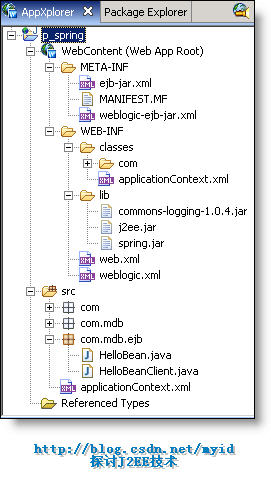
三。在weblogic控制台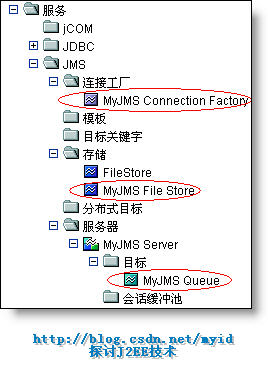
配置JMS 文件存储: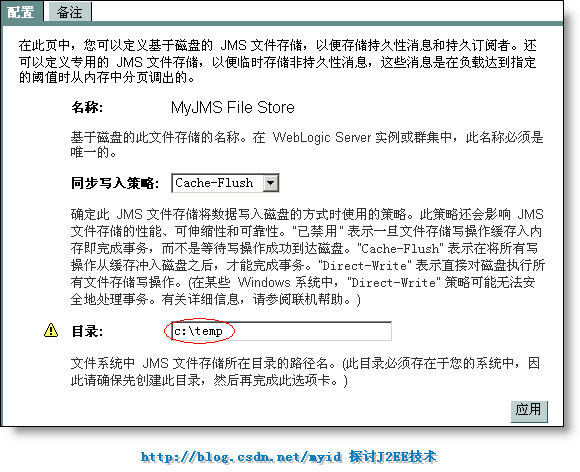
配置JMS 服务器: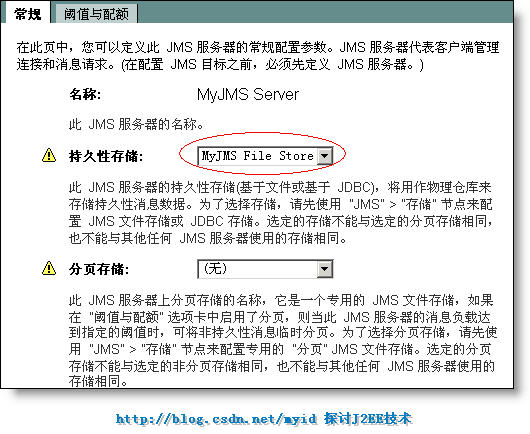
配置JMS 队列: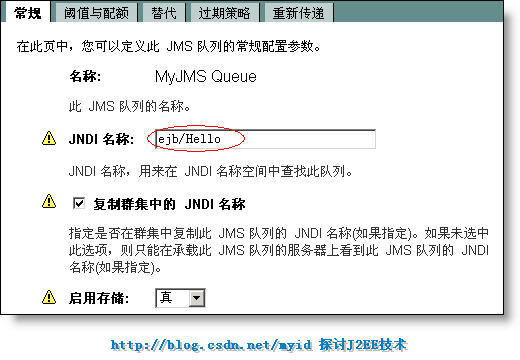
配置JMS 连接工厂: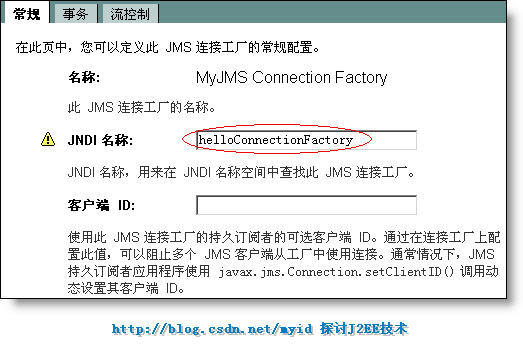
四。运行测试代码,运行结果如下: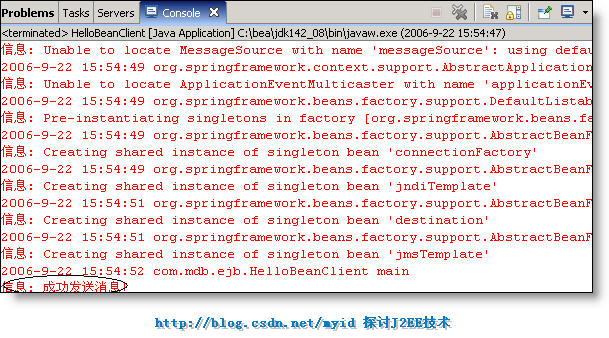
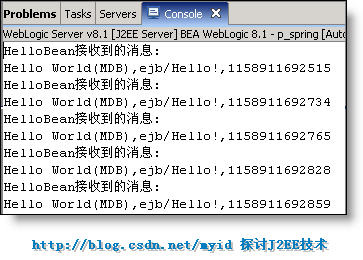






















 209
209

 被折叠的 条评论
为什么被折叠?
被折叠的 条评论
为什么被折叠?








